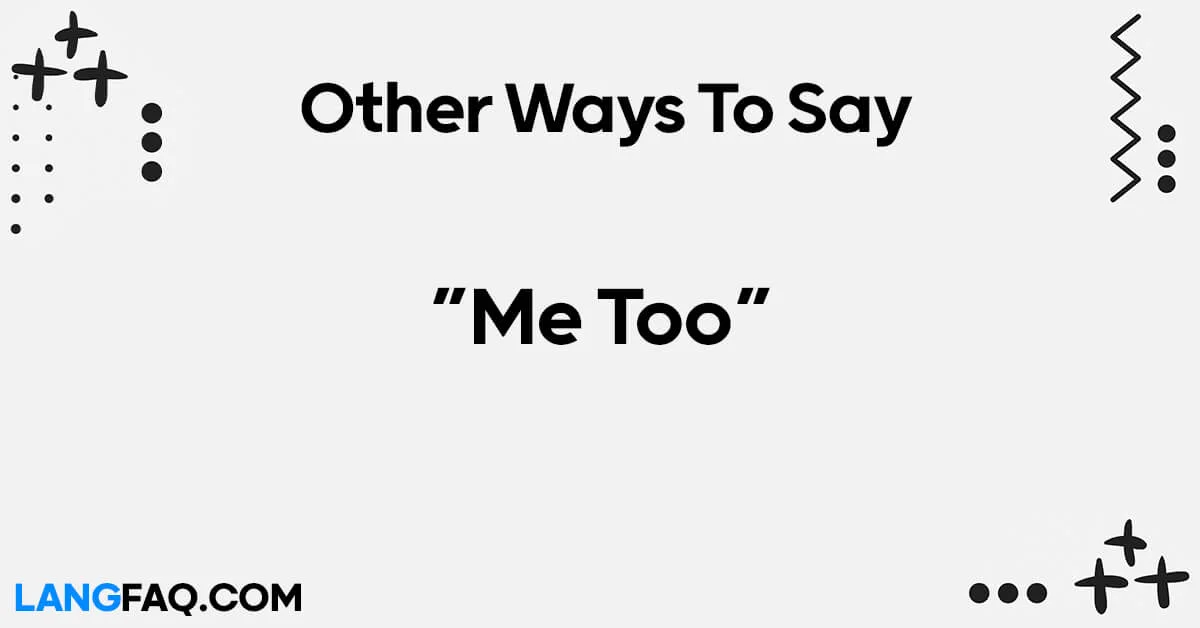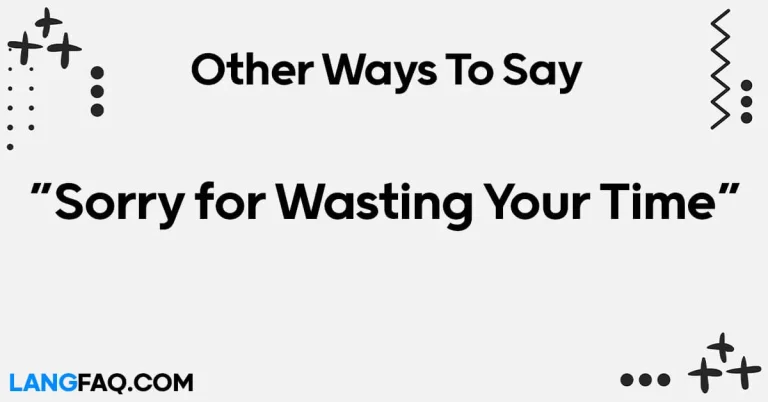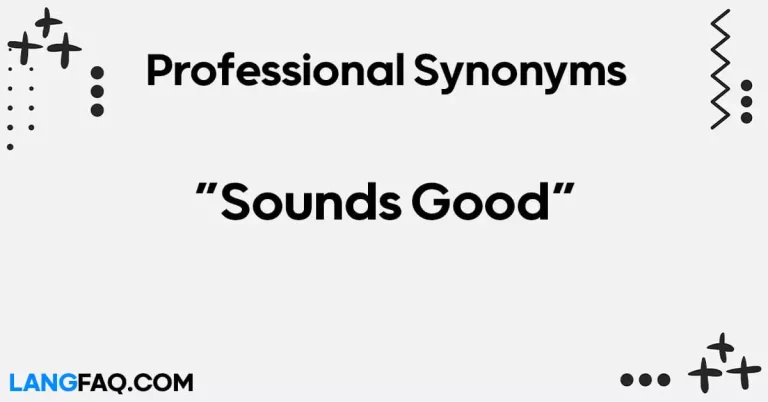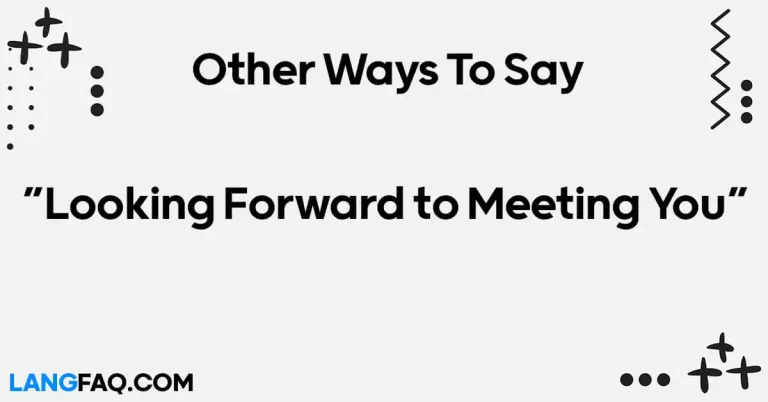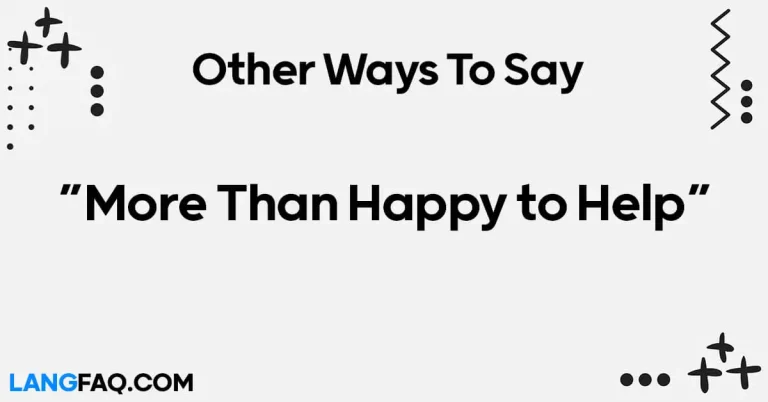In our daily conversations, expressing agreement or solidarity is essential for effective communication. However, constantly repeating “Me Too” might sound monotonous. Fear not, as we delve into 12 other creative ways to convey the same sentiment, enriching your linguistic repertoire and making your interactions more engaging.
12 Other Ways to Say “Me Too”
Here are 12 other ways to say “Me Too”:
- I agree.
- Likewise.
- Same here.
- Count me in.
- That applies to me as well.
- Ditto.
- I feel the same.
- I share your sentiment.
- In my case too.
- I concur.
- My sentiments exactly.
- You took the words right out of my mouth.
| Expression | Meaning | Example |
|---|---|---|
| I agree | Expressing alignment or accord | A: “I think the movie was fantastic.” <br> B: “I agree, it was amazing!” |
| Likewise | Indicating similarity or agreement | A: “I enjoyed the concert.” <br> B: “Likewise, it was a great performance.” |
| Same here | Affirming shared experience | A: “I love traveling.” <br> B: “Same here, exploring new places is so exciting.” |
| Count me in | Expressing willingness to participate | A: “We’re planning a hike, are you interested?” <br> B: “Count me in, I love hiking!” |
| That applies to me too | Acknowledging shared relevance | A: “I find meditation helpful.” <br> B: “That applies to me too, it really calms the mind.” |
| Ditto | Informal agreement | A: “Pizza is my favorite food.” <br> B: “Ditto! Can’t get enough of it.” |
| I feel the same | Expressing shared emotions | A: “I’m excited for the trip.” <br> B: “I feel the same, it’s going to be fantastic.” |
| I share your sentiment | Indicating agreement with feelings | A: “I’m thrilled about the promotion.” <br> B: “I share your sentiment, it’s well-deserved.” |
| In my case too | Affirming shared experience | A: “I love reading mystery novels.” <br> B: “In my case too, they’re so captivating.” |
| I concur | Formal agreement | A: “The proposal seems feasible.” <br> B: “I concur, it’s a well-thought-out plan.” |
| My sentiments exactly | Confirming identical feelings | A: “I find the movie inspiring.” <br> B: “My sentiments exactly, it’s truly motivating.” |
| You took the words right out of my mouth | Expressing perfect agreement | A: “I think we should go for a walk.” <br> B: “You took the words right out of my mouth, I was just about to suggest the same!” |
In conclusion, these alternative expressions to “Me Too” offer a diverse range of ways to convey agreement, solidarity, and shared experiences in conversations. By incorporating these varied phrases into everyday dialogue, individuals can enrich their communication skills and foster deeper connections with others.
Is It Correct to Say “Me Too”?
Yes, it is correct to say “Me too” in informal contexts to express agreement or to indicate that you share the same sentiment or experience as someone else. This phrase is commonly used in casual conversations among friends, family members, or acquaintances. It’s a simple and informal way to convey alignment with someone else’s statement or sentiment. However, in formal or professional settings, it’s often preferable to use more formal expressions such as “I agree” or “Likewise” to maintain professionalism.
Professional Mail Example With “Me Too”
Subject: Agreement on Project Timeline
Dear [Recipient],
I hope this email finds you well. Following our discussion earlier today regarding the project timeline, I wanted to express my agreement with the proposed deadlines and milestones. “Me too,” as they align perfectly with our objectives and the expectations of our stakeholders.
I appreciate the thoroughness with which you’ve outlined the project plan, and I am confident that with our combined efforts, we will successfully meet all project deadlines. If there are any additional resources or support needed from my end to ensure the timely completion of tasks, please do not hesitate to let me know.
Looking forward to our continued collaboration and the successful execution of the project.
Best regards, [Your Name]
I Agree
In various social and professional settings, expressing agreement is crucial for effective communication. “I agree” is a simple yet powerful phrase that conveys alignment with someone else’s viewpoint or opinion. It can be used in both formal and informal contexts to affirm shared sentiments.
Usage and Examples:
- Formal Context: During a business meeting, acknowledging agreement with a colleague’s proposal can demonstrate collaboration and support. For instance, “I agree with Sarah’s suggestion to implement the new marketing strategy. It aligns perfectly with our objectives.”
- Informal Context: Among friends discussing weekend plans, expressing agreement can foster camaraderie. For example, “I agree, going for a hike sounds like a great idea!”
Variations:
- Colleagues: “I’m in agreement.”
- Friends: “Totally agree!”
- Mentor-Mentee: “I concur with your analysis.”
Tips:
- Use “I agree” when you genuinely align with the other person’s viewpoint.
- Avoid overusing this phrase to maintain sincerity and authenticity in your agreements.
Related Insights:
According to the Cambridge Dictionary, “I agree” is defined as expressing that you have the same opinion as someone else.
Example Email:
Subject: Agreement on Project Timeline
Hi [Colleague’s Name],
I hope this email finds you well. After reviewing the project timeline you proposed during yesterday’s meeting, I wanted to express my agreement with the proposed deadlines and milestones. I believe they are realistic and achievable given the resources available to us. Let’s proceed with this plan moving forward.
Looking forward to our continued collaboration.
Best regards, [Your Name]
Likewise
“Likewise” is a versatile word that can be used to indicate agreement, express similarity, or reciprocate a sentiment. Its flexibility makes it suitable for various social and professional contexts, adding depth to conversations.
Usage and Examples:
- Formal Context: In a business negotiation, acknowledging a counterpart’s concession with “Likewise” can maintain a positive atmosphere. For instance, “We’re willing to compromise on the delivery timeline.” “Likewise, we appreciate your flexibility on the payment terms.”
- Informal Context: Among friends discussing shared interests, “Likewise” can affirm commonalities. For example, “I love Italian cuisine.” “Likewise, it’s my favorite too!”
Variations:
- Colleagues: “I share your sentiment.”
- Friends: “Same here!”
- Mentor-Mentee: “I echo your thoughts.”
Tips:
- Use “Likewise” to acknowledge shared sentiments or actions.
- Avoid using it sarcastically, as it may come across as insincere.
Related Insights:
According to Merriam-Webster, “Likewise” is defined as in the same manner, in addition, also.
Example Email:
Subject: Appreciation for Team Collaboration
Hi [Team],
I wanted to extend my gratitude for the collaborative effort on the recent project. Your dedication and hard work have been instrumental in achieving our milestones. Likewise, I appreciate the opportunity to work with such a talented team.
Looking forward to our continued success together.
Best regards, [Your Name]
Same Here
“Same here” is an informal yet effective way to express agreement or shared experiences. It’s commonly used in casual conversations among friends, colleagues, or acquaintances to affirm common sentiments.
Usage and Examples:
- Formal Context: During a team meeting, acknowledging a colleague’s frustration with workload can be done with “Same here” to show solidarity. For example, “I’m feeling overwhelmed with the project deadlines.” “Same here, let’s brainstorm ways to manage our tasks more efficiently.”
- Informal Context: Among friends discussing hobbies, “Same here” can indicate shared interests. For instance, “I love playing guitar.” “Same here, music is my passion too!”
Variations:
- Colleagues: “I’m in the same boat.”
- Friends: “Me too!”
- Mentor-Mentee: “I understand, I’ve been there too.”
Tips:
- Use “Same here” to affirm agreement or shared experiences in informal settings.
- Keep the tone light and friendly when using this phrase.
Related Insights:
According to Oxford Languages, “Same here” is defined as an informal expression used to say that you are in the same situation or have the same feelings as someone else.
Example Email:
Subject: Appreciation for Team Collaboration
Hi [Team],
I just wanted to take a moment to express my appreciation for everyone’s hard work and dedication on the recent project. The results speak for themselves, and I’m proud to be part of such a talented team. Same here, let’s keep up the fantastic work!
Best regards, [Your Name]
Count Me In
“Count me in” is a positive and enthusiastic way to express agreement or willingness to participate in a proposed activity or plan. It conveys eagerness and support, making it suitable for various contexts.
Usage and Examples:
- Formal Context: In a brainstorming session, expressing readiness to contribute with “Count me in” can encourage collaboration. For example, “We’re organizing a workshop next week.” “Count me in, I’d love to share my insights on the topic.”
- Informal Context: Among friends planning a trip, “Count me in” expresses excitement and commitment. For instance, “We’re going camping this weekend.” “Count me in, I’ll bring the snacks!”
Variations:
- Colleagues: “I’m onboard.”
- Friends: “I’m game!”
- Mentor-Mentee: “Include me in your plans.”
Tips:
- Use “Count me in” to show enthusiasm and support for a proposed activity or plan.
- Ensure that your commitment is genuine when using this phrase.
Related Insights:
According to Collins Dictionary, “Count me in” is defined as an informal way of saying that you want to join a group of people in doing something.
Example Email:
Subject: Participation in Team Building Activity
Hi [Team],
I’m excited to announce that we’re planning a team building activity next month to strengthen our bond and enhance collaboration. Count me in, I believe it will be a fantastic opportunity for us to connect outside of work and build stronger relationships.
Looking forward to it!
Best regards, [Your Name]
That Applies to Me Too
“That applies to me too” is a polite and affirming way to acknowledge shared relevance or experiences. It emphasizes commonality and understanding, making it suitable for various interpersonal interactions.
Usage and Examples:
- Formal Context: During a presentation, acknowledging the applicability of a concept with “That applies to me too” can demonstrate engagement. For example, “The findings from this study are relevant to our project.” “That applies to me too, I’ve encountered similar challenges in my research.”
- Informal Context: Among friends discussing hobbies, “That applies to me too” can affirm shared interests. For instance, “I enjoy photography as a hobby.” “That applies to me too, capturing moments is truly fulfilling!”
Variations:
- Colleagues: “I can relate to that.”
- Friends: “I’m in the same boat.”
- Mentor-Mentee: “I’ve had similar experiences.”
Tips:
- Use “That applies to me too” to acknowledge shared relevance or experiences respectfully.
- Ensure that your response adds value to the conversation when using this phrase.
Related Insights:
According to Vocabulary.com, “That applies to me too” means expressing that a statement or situation also relates to oneself.
Example Email:
Subject: Acknowledgment of Shared Challenges
Hi [Team],
I wanted to thank everyone for their insightful contributions during yesterday’s brainstorming session. The challenges we discussed resonate with my own experiences, and I appreciate the opportunity to learn from each of you. That applies to me too, and I believe by working together, we can overcome these obstacles and achieve our goals.
Best regards, [Your Name]
Ditto
“Ditto” is an informal expression used to indicate agreement or confirmation of a statement. It is concise yet effective in affirming shared sentiments, making it suitable for casual conversations.
Usage and Examples:
- Formal Context: During a team discussion, affirming agreement with a colleague’s suggestion using “Ditto” can streamline communication. For example, “I propose we prioritize customer feedback.” “Ditto, it’s crucial for improving our products and services.”
- Informal Context: Among friends discussing movie preferences, “Ditto” can indicate shared tastes. For instance, “I love action movies.” “Ditto, they’re my favorite genre too!”
Variations:
- Colleagues: “I’m on the same page.”
- Friends: “Me too!”
- Mentor-Mentee: “I echo your thoughts.”
Tips:
- Use “Ditto” in informal settings to affirm agreement or confirmation succinctly.
- Avoid using it in formal or professional contexts, as it may come across as too casual.
Related Insights:
According to Dictionary.com, “Ditto” is defined as a duplicate; copy.
Example Email:
Subject: Agreement on Project Approach
Hi [Team],
I wanted to follow up on our discussion regarding the project approach. I’m in full agreement with the proposed strategy outlined in the meeting. Ditto, I believe it aligns well with our objectives and timelines.
Looking forward to our continued collaboration.
Best regards, [Your Name]
I Feel the Same
“I feel the same” is a straightforward way to express agreement or shared emotions. It conveys empathy and understanding, making it suitable for both formal and informal conversations.
Usage and Examples:
- Formal Context: During a team meeting, acknowledging agreement with a colleague’s proposal using “I feel the same” can foster collaboration. For example, “I believe we should prioritize customer satisfaction.” “I feel the same, it’s essential for long-term success.”
- Informal Context: Among friends discussing a recent movie, “I feel the same” can indicate shared opinions. For instance, “The ending was so unexpected.” “I feel the same, it kept me on the edge of my seat!”
Variations:
- Colleagues: “I share your sentiment.”
- Friends: “I’m with you on this one.”
- Mentor-Mentee: “I understand completely.”
Tips:
- Use “I feel the same” to express agreement or empathy genuinely.
- Ensure that your response adds value to the conversation and validates the other person’s perspective.
Related Insights:
According to Merriam-Webster, “I feel the same” is defined as expressing agreement or similarity of feelings.
Example Email:
Subject: Agreement on Project Direction
Hi [Team],
After reviewing the proposed direction for the project, I wanted to express my agreement with the outlined strategy. I feel the same, and I believe it aligns well with our goals and objectives moving forward.
Looking forward to our continued progress.
Best regards, [Your Name]
I Share Your Sentiment
“I share your sentiment” is a formal way to express agreement or alignment with someone else’s feelings or opinions. It conveys empathy and understanding, making it suitable for professional interactions.
Usage and Examples:
- Formal Context: During a business negotiation, acknowledging a counterpart’s concerns with “I share your sentiment” can build rapport. For example, “We’re apprehensive about the proposed changes.” “I share your sentiment, and we’ll work together to address these concerns.”
- Informal Context: Among colleagues discussing upcoming deadlines, “I share your sentiment” can indicate solidarity. For instance, “I’m feeling the pressure with the project timeline.” “I share your sentiment, let’s prioritize tasks efficiently.”
Variations:
- Colleagues: “We’re on the same page.”
- Friends: “I’m in the same boat.”
- Mentor-Mentee: “I understand completely.”
Tips:
- Use “I share your sentiment” to validate someone else’s feelings or opinions respectfully.
- Ensure that your response acknowledges the other person’s perspective and fosters understanding.
Related Insights:
According to the Oxford English Dictionary, “I share your sentiment” means expressing agreement with someone else’s feelings or opinions.
Example Email:
Subject: Acknowledgment of Concerns
Hi [Team],
I wanted to address the concerns raised during yesterday’s meeting regarding the project timeline. I share your sentiment, and I understand the importance of meeting our deadlines while ensuring the quality of our work. Let’s collaborate to find solutions that accommodate everyone’s needs.
Best regards, [Your Name]
In My Case Too
“In my case too” is a straightforward way to acknowledge shared experiences or perspectives. It emphasizes commonality and understanding, making it suitable for various interpersonal interactions.
Usage and Examples:
- Formal Context: During a team discussion, acknowledging a colleague’s challenges with “In my case too” can demonstrate empathy. For example, “I’ve encountered similar obstacles in my research.” “In my case too, let’s brainstorm solutions together.”
- Informal Context: Among friends discussing travel experiences, “In my case too” can affirm shared adventures. For instance, “I love exploring new cultures.” “In my case too, traveling enriches my life.”
Variations:
- Colleagues: “I’ve had similar experiences.”
- Friends: “I’ve been there too!”
- Mentor-Mentee: “I understand, I’ve faced similar challenges.”
Tips:
- Use “In my case too” to acknowledge shared experiences or perspectives genuinely.
- Ensure that your response validates the other person’s perspective and fosters understanding.
Related Insights:
According to Vocabulary.com, “In my case too” means expressing that a statement or situation also applies to oneself.
Example Email:
Subject: Understanding Shared Challenges
Hi [Team],
I wanted to address the challenges we’ve been facing with meeting deadlines on the project. In my case too, I’ve encountered similar obstacles in previous projects. Let’s collaborate to find solutions that work for everyone and ensure the success of our project.
Best regards, [Your Name]
I Concur
“I concur” is a formal and respectful way to express agreement or alignment with someone else’s opinion or decision. It conveys professionalism and cooperation, making it suitable for professional interactions.
Usage and Examples:
- Formal Context: During a board meeting, expressing agreement with a proposed resolution using “I concur” can demonstrate support. For example, “I believe we should proceed with the merger.” “I concur, it’s a strategic move for our company’s growth.”
- Informal Context: Among colleagues discussing project priorities, “I concur” can indicate alignment. For instance, “I think we should focus on improving customer service.” “I concur, it’s vital for maintaining client satisfaction.”
Variations:
- Colleagues: “I’m in agreement.”
- Friends: “Totally agree!”
- Mentor-Mentee: “I share your perspective.”
Tips:
- Use “I concur” to express agreement or alignment with professionalism and respect.
- Ensure that your response contributes to the conversation and reinforces collaboration.
Related Insights:
According to Merriam-Webster, “I concur” means expressing agreement or approval.
Example Email:
Subject: Agreement on Strategic Direction
Hi [Team],
After reviewing the proposed strategic direction for the upcoming quarter, I wanted to express my agreement with the outlined plan. I concur, and I believe it sets us on the path to achieving our objectives effectively.
Looking forward to our continued progress.
Best regards, [Your Name]
My Sentiments Exactly
“My sentiments exactly” is an emphatic way to express perfect agreement with someone else’s statement or sentiment. It conveys strong alignment and understanding, making it suitable for both formal and informal interactions.
Usage and Examples:
- Formal Context: During a team discussion, affirming agreement with a colleague’s analysis using “My sentiments exactly” can reinforce shared perspectives. For example, “I believe we should prioritize innovation in our product development.” “My sentiments exactly, it’s crucial for staying competitive in the market.”
- Informal Context: Among friends discussing personal values, “My sentiments exactly” can indicate deep agreement. For instance, “I value honesty above all.” “My sentiments exactly, integrity is essential in all aspects of life.”
Variations:
- Colleagues: “I couldn’t agree more.”
- Friends: “Absolutely!”
- Mentor-Mentee: “I share your perspective completely.”
Tips:
- Use “My sentiments exactly” to express strong agreement or alignment sincerely.
- Ensure that your response reinforces the other person’s viewpoint and strengthens the connection.
Related Insights:
According to Collins Dictionary, “My sentiments exactly” means expressing complete agreement with someone else’s opinion or feeling.
Example Email:
Subject: Alignment on Project Priorities
Hi [Team],
I wanted to reaffirm my support for the project priorities outlined in our recent discussion. My sentiments exactly, I believe focusing on customer engagement and product quality will drive our success in the upcoming quarter.
Looking forward to our continued collaboration.
Best regards, [Your Name]
You Took the Words Right Out of My Mouth
“You took the words right out of my mouth” is an informal expression used to convey perfect agreement with someone else’s statement or sentiment. It emphasizes the immediacy and accuracy of the agreement, making it suitable for casual interactions.
Usage and Examples:
- Formal Context: During a brainstorming session, affirming agreement with a colleague’s idea using “You took the words right out of my mouth” can indicate shared insights. For example, “I suggest we explore new marketing channels.” “You took the words right out of my mouth, it’s a strategy worth considering.”
- Informal Context: Among friends discussing weekend plans, “You took the words right out of my mouth” can indicate shared preferences. For instance, “I was thinking of going to the beach.” “You took the words right out of my mouth, I was just about to suggest the same!”
Variations:
- Colleagues: “You read my mind.”
- Friends: “Exactly what I was thinking!”
- Mentor-Mentee: “You’ve captured my thoughts perfectly.”
Tips:
- Use “You took the words right out of my mouth” to express immediate and accurate agreement or alignment informally.
- Ensure that your response adds enthusiasm and reinforces the connection with the other person.
Related Insights:
According to Vocabulary.com, “You took the words right out of my mouth” means expressing that someone has said exactly what you were thinking or feeling.
Example Email:
Subject: Excitement for Team Building Event
Hi [Team],
I just wanted to express my enthusiasm for the upcoming team building event. You took the words right out of my mouth, I believe it will be a fantastic opportunity for us to bond and strengthen our teamwork.
Looking forward to it!
Best regards, [Your Name]
I’m in Agreement
“I’m in agreement” is a formal and straightforward way to express alignment with someone else’s viewpoint or decision. It conveys professionalism and cooperation, making it suitable for professional interactions.
Usage and Examples:
- Formal Context: During a project review meeting, expressing agreement with a colleague’s proposal using “I’m in agreement” can demonstrate support. For example, “I propose we allocate additional resources to this task.” “I’m in agreement, it’s essential for meeting our deadlines.”
- Informal Context: Among colleagues discussing department goals, “I’m in agreement” can indicate shared objectives. For instance, “I think we should focus on improving communication.” “I’m in agreement, clear communication is key to our success.”
Variations:
- Colleagues: “I concur.”
- Friends: “I’m on board.”
- Mentor-Mentee: “I share your perspective.”
Tips:
- Use “I’m in agreement” to express alignment with professionalism and clarity.
- Ensure that your response contributes positively to the conversation and reinforces collaboration.
Related Insights:
According to Oxford Languages, “I’m in agreement” means expressing alignment or accord with someone else’s viewpoint or decision.
Example Email:
Subject: Support for New Initiative
Hi [Team],
I wanted to express my support for the new initiative proposed during yesterday’s meeting. I’m in agreement, and I believe it aligns well with our departmental objectives and priorities.
Looking forward to its implementation.
Best regards, [Your Name]
Totally Agree!
“Totally agree!” is an informal and enthusiastic way to express full alignment or agreement with someone else’s statement or sentiment. It conveys enthusiasm and positivity, making it suitable for casual interactions.
Usage and Examples:
- Formal Context: During a team brainstorming session, affirming agreement with a colleague’s idea using “Totally agree!” can encourage collaboration. For example, “I suggest we explore new marketing channels.” “Totally agree, it’s worth considering for expanding our reach.”
- Informal Context: Among friends discussing weekend plans, “Totally agree!” can indicate excitement and alignment. For instance, “Let’s go hiking this weekend.” “Totally agree, I’ve been wanting to get outdoors!”
Variations:
- Colleagues: “Completely on board!”
- Friends: “Absolutely!”
- Mentor-Mentee: “I’m fully supportive!”
Tips:
- Use “Totally agree!” to express enthusiastic alignment or agreement informally.
- Ensure that your response adds energy and positivity to the conversation.
Related Insights:
According to Merriam-Webster, “Totally agree!” means expressing full alignment or agreement with someone else’s statement or sentiment.
Example Email:
Subject: Excitement for Team Building Event
Hi [Team],
I just wanted to express my excitement for the upcoming team building event. Totally agree, I believe it will be a fantastic opportunity for us to bond and strengthen our teamwork.
Looking forward to it!
Best regards, [Your Name]
FAQs
1. What are some alternative ways to say “Me Too”?
- Absolutely!
- I can relate!
- I feel the same way.
- That’s my sentiment exactly!
- We’re all in accord.
- I’m with you on this one.
- I’ve been there too.
- That’s exactly how I feel.
- I’ve had the same experience.
- We’re on the same page.
- I understand completely.
- I’m in the same boat.
2. How do these alternatives enhance conversations?
- These alternatives inject enthusiasm, empathy, and understanding into conversations, fostering deeper connections and more engaging interactions.
3. Can these alternatives be used interchangeably?
- Yes, these alternatives can be used interchangeably based on the context and individual preference, enriching communication with diverse expressions of agreement and solidarity.
4. Are there cultural differences in the use of these expressions?
- While some expressions may be more prevalent in certain cultures, the essence of agreement and solidarity remains universal, transcending cultural boundaries.
5. How can I incorporate these alternatives into everyday conversations?
- Practice incorporating these expressions into your daily interactions to enrich your communication skills and foster deeper connections with others.
6. Are there situations where using “Me Too” is more appropriate than the alternatives?
- “Me Too” may be more suitable in casual or informal settings, while the alternatives offer versatility and depth for various contexts and tones.
Conclusion:
Diversifying your vocabulary with alternative expressions for “Me Too” enhances the richness of your conversations, fostering deeper connections and mutual understanding. By incorporating these varied expressions into your interactions, you can enrich your communication skills and cultivate stronger relationships with others.

